Wireless Power Transmission and Inverters for Charging Electronic Devices
VerifiedAdded on 2023/01/19
|5
|1909
|76
AI Summary
This article discusses the challenges faced by designers and engineers in power supply and the potential of wireless power transmission and inverters for charging electronic devices. It explores the concepts of radiative and non-radiative power transmission, as well as the use of magnetic induction and magnetic resonant coupling. The focus is on integrating inverters and wireless power transmission in electronics.
Contribute Materials
Your contribution can guide someone’s learning journey. Share your
documents today.
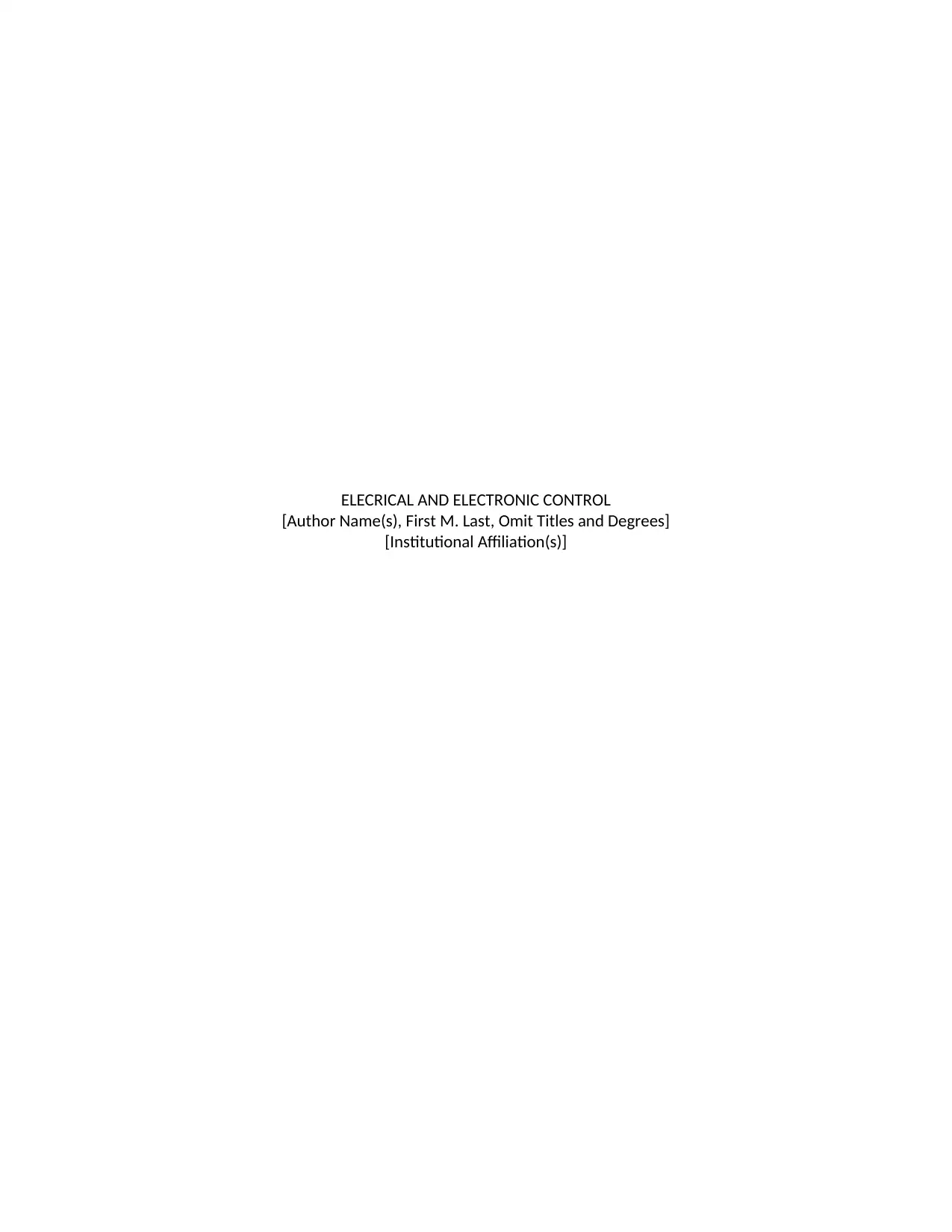
ELECRICAL AND ELECTRONIC CONTROL
[Author Name(s), First M. Last, Omit Titles and Degrees]
[Institutional Affiliation(s)]
[Author Name(s), First M. Last, Omit Titles and Degrees]
[Institutional Affiliation(s)]
Secure Best Marks with AI Grader
Need help grading? Try our AI Grader for instant feedback on your assignments.
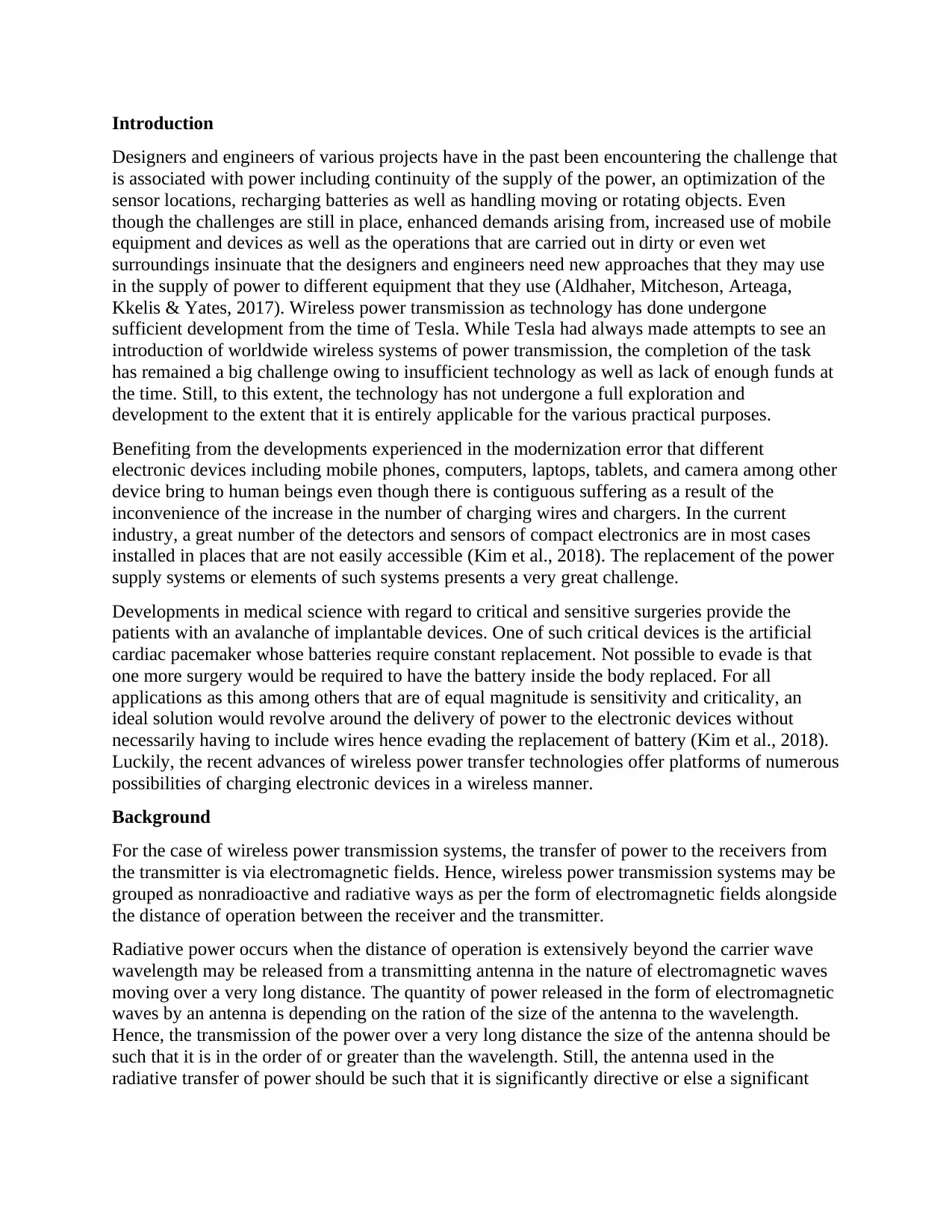
Introduction
Designers and engineers of various projects have in the past been encountering the challenge that
is associated with power including continuity of the supply of the power, an optimization of the
sensor locations, recharging batteries as well as handling moving or rotating objects. Even
though the challenges are still in place, enhanced demands arising from, increased use of mobile
equipment and devices as well as the operations that are carried out in dirty or even wet
surroundings insinuate that the designers and engineers need new approaches that they may use
in the supply of power to different equipment that they use (Aldhaher, Mitcheson, Arteaga,
Kkelis & Yates, 2017). Wireless power transmission as technology has done undergone
sufficient development from the time of Tesla. While Tesla had always made attempts to see an
introduction of worldwide wireless systems of power transmission, the completion of the task
has remained a big challenge owing to insufficient technology as well as lack of enough funds at
the time. Still, to this extent, the technology has not undergone a full exploration and
development to the extent that it is entirely applicable for the various practical purposes.
Benefiting from the developments experienced in the modernization error that different
electronic devices including mobile phones, computers, laptops, tablets, and camera among other
device bring to human beings even though there is contiguous suffering as a result of the
inconvenience of the increase in the number of charging wires and chargers. In the current
industry, a great number of the detectors and sensors of compact electronics are in most cases
installed in places that are not easily accessible (Kim et al., 2018). The replacement of the power
supply systems or elements of such systems presents a very great challenge.
Developments in medical science with regard to critical and sensitive surgeries provide the
patients with an avalanche of implantable devices. One of such critical devices is the artificial
cardiac pacemaker whose batteries require constant replacement. Not possible to evade is that
one more surgery would be required to have the battery inside the body replaced. For all
applications as this among others that are of equal magnitude is sensitivity and criticality, an
ideal solution would revolve around the delivery of power to the electronic devices without
necessarily having to include wires hence evading the replacement of battery (Kim et al., 2018).
Luckily, the recent advances of wireless power transfer technologies offer platforms of numerous
possibilities of charging electronic devices in a wireless manner.
Background
For the case of wireless power transmission systems, the transfer of power to the receivers from
the transmitter is via electromagnetic fields. Hence, wireless power transmission systems may be
grouped as nonradioactive and radiative ways as per the form of electromagnetic fields alongside
the distance of operation between the receiver and the transmitter.
Radiative power occurs when the distance of operation is extensively beyond the carrier wave
wavelength may be released from a transmitting antenna in the nature of electromagnetic waves
moving over a very long distance. The quantity of power released in the form of electromagnetic
waves by an antenna is depending on the ration of the size of the antenna to the wavelength.
Hence, the transmission of the power over a very long distance the size of the antenna should be
such that it is in the order of or greater than the wavelength. Still, the antenna used in the
radiative transfer of power should be such that it is significantly directive or else a significant
Designers and engineers of various projects have in the past been encountering the challenge that
is associated with power including continuity of the supply of the power, an optimization of the
sensor locations, recharging batteries as well as handling moving or rotating objects. Even
though the challenges are still in place, enhanced demands arising from, increased use of mobile
equipment and devices as well as the operations that are carried out in dirty or even wet
surroundings insinuate that the designers and engineers need new approaches that they may use
in the supply of power to different equipment that they use (Aldhaher, Mitcheson, Arteaga,
Kkelis & Yates, 2017). Wireless power transmission as technology has done undergone
sufficient development from the time of Tesla. While Tesla had always made attempts to see an
introduction of worldwide wireless systems of power transmission, the completion of the task
has remained a big challenge owing to insufficient technology as well as lack of enough funds at
the time. Still, to this extent, the technology has not undergone a full exploration and
development to the extent that it is entirely applicable for the various practical purposes.
Benefiting from the developments experienced in the modernization error that different
electronic devices including mobile phones, computers, laptops, tablets, and camera among other
device bring to human beings even though there is contiguous suffering as a result of the
inconvenience of the increase in the number of charging wires and chargers. In the current
industry, a great number of the detectors and sensors of compact electronics are in most cases
installed in places that are not easily accessible (Kim et al., 2018). The replacement of the power
supply systems or elements of such systems presents a very great challenge.
Developments in medical science with regard to critical and sensitive surgeries provide the
patients with an avalanche of implantable devices. One of such critical devices is the artificial
cardiac pacemaker whose batteries require constant replacement. Not possible to evade is that
one more surgery would be required to have the battery inside the body replaced. For all
applications as this among others that are of equal magnitude is sensitivity and criticality, an
ideal solution would revolve around the delivery of power to the electronic devices without
necessarily having to include wires hence evading the replacement of battery (Kim et al., 2018).
Luckily, the recent advances of wireless power transfer technologies offer platforms of numerous
possibilities of charging electronic devices in a wireless manner.
Background
For the case of wireless power transmission systems, the transfer of power to the receivers from
the transmitter is via electromagnetic fields. Hence, wireless power transmission systems may be
grouped as nonradioactive and radiative ways as per the form of electromagnetic fields alongside
the distance of operation between the receiver and the transmitter.
Radiative power occurs when the distance of operation is extensively beyond the carrier wave
wavelength may be released from a transmitting antenna in the nature of electromagnetic waves
moving over a very long distance. The quantity of power released in the form of electromagnetic
waves by an antenna is depending on the ration of the size of the antenna to the wavelength.
Hence, the transmission of the power over a very long distance the size of the antenna should be
such that it is in the order of or greater than the wavelength. Still, the antenna used in the
radiative transfer of power should be such that it is significantly directive or else a significant
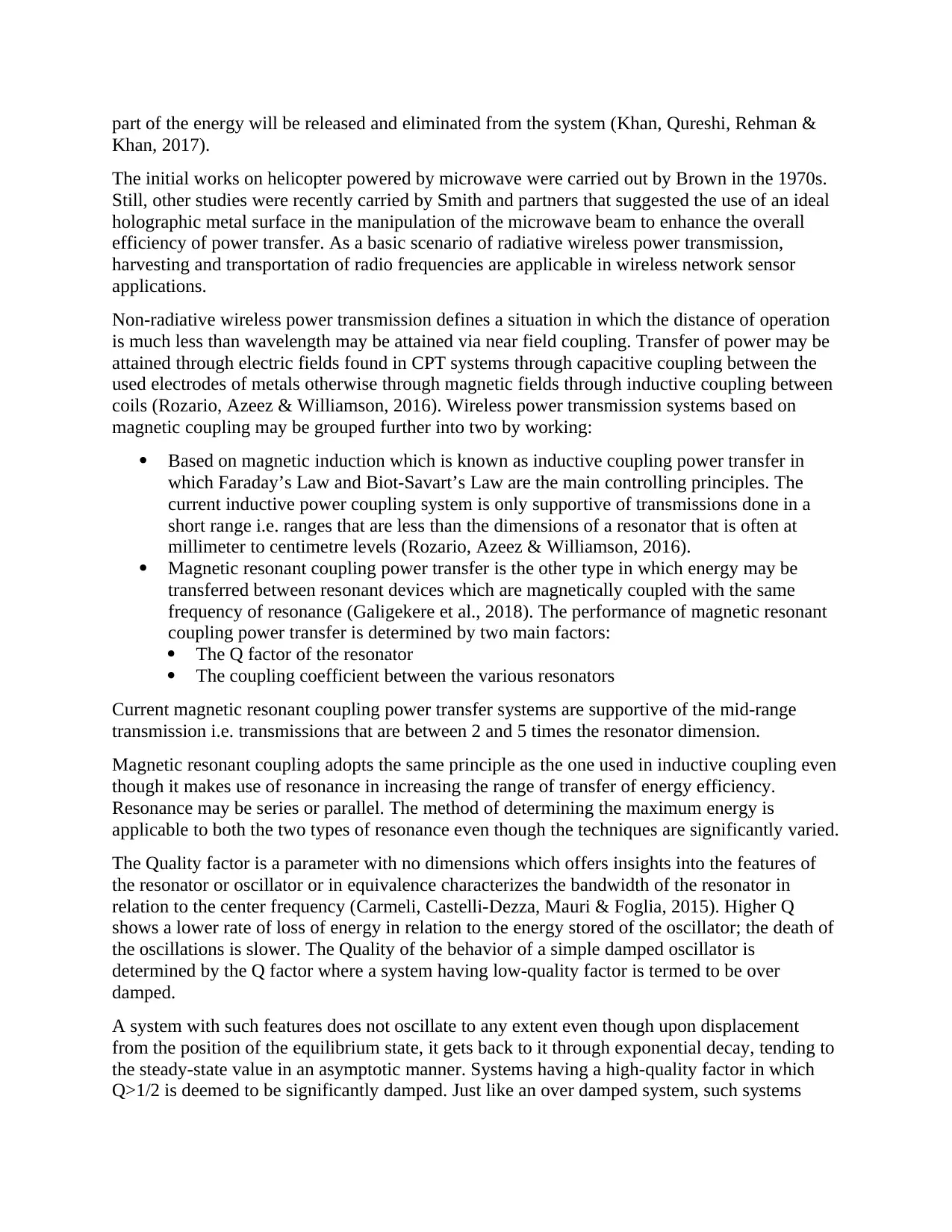
part of the energy will be released and eliminated from the system (Khan, Qureshi, Rehman &
Khan, 2017).
The initial works on helicopter powered by microwave were carried out by Brown in the 1970s.
Still, other studies were recently carried by Smith and partners that suggested the use of an ideal
holographic metal surface in the manipulation of the microwave beam to enhance the overall
efficiency of power transfer. As a basic scenario of radiative wireless power transmission,
harvesting and transportation of radio frequencies are applicable in wireless network sensor
applications.
Non-radiative wireless power transmission defines a situation in which the distance of operation
is much less than wavelength may be attained via near field coupling. Transfer of power may be
attained through electric fields found in CPT systems through capacitive coupling between the
used electrodes of metals otherwise through magnetic fields through inductive coupling between
coils (Rozario, Azeez & Williamson, 2016). Wireless power transmission systems based on
magnetic coupling may be grouped further into two by working:
Based on magnetic induction which is known as inductive coupling power transfer in
which Faraday’s Law and Biot-Savart’s Law are the main controlling principles. The
current inductive power coupling system is only supportive of transmissions done in a
short range i.e. ranges that are less than the dimensions of a resonator that is often at
millimeter to centimetre levels (Rozario, Azeez & Williamson, 2016).
Magnetic resonant coupling power transfer is the other type in which energy may be
transferred between resonant devices which are magnetically coupled with the same
frequency of resonance (Galigekere et al., 2018). The performance of magnetic resonant
coupling power transfer is determined by two main factors:
The Q factor of the resonator
The coupling coefficient between the various resonators
Current magnetic resonant coupling power transfer systems are supportive of the mid-range
transmission i.e. transmissions that are between 2 and 5 times the resonator dimension.
Magnetic resonant coupling adopts the same principle as the one used in inductive coupling even
though it makes use of resonance in increasing the range of transfer of energy efficiency.
Resonance may be series or parallel. The method of determining the maximum energy is
applicable to both the two types of resonance even though the techniques are significantly varied.
The Quality factor is a parameter with no dimensions which offers insights into the features of
the resonator or oscillator or in equivalence characterizes the bandwidth of the resonator in
relation to the center frequency (Carmeli, Castelli-Dezza, Mauri & Foglia, 2015). Higher Q
shows a lower rate of loss of energy in relation to the energy stored of the oscillator; the death of
the oscillations is slower. The Quality of the behavior of a simple damped oscillator is
determined by the Q factor where a system having low-quality factor is termed to be over
damped.
A system with such features does not oscillate to any extent even though upon displacement
from the position of the equilibrium state, it gets back to it through exponential decay, tending to
the steady-state value in an asymptotic manner. Systems having a high-quality factor in which
Q>1/2 is deemed to be significantly damped. Just like an over damped system, such systems
Khan, 2017).
The initial works on helicopter powered by microwave were carried out by Brown in the 1970s.
Still, other studies were recently carried by Smith and partners that suggested the use of an ideal
holographic metal surface in the manipulation of the microwave beam to enhance the overall
efficiency of power transfer. As a basic scenario of radiative wireless power transmission,
harvesting and transportation of radio frequencies are applicable in wireless network sensor
applications.
Non-radiative wireless power transmission defines a situation in which the distance of operation
is much less than wavelength may be attained via near field coupling. Transfer of power may be
attained through electric fields found in CPT systems through capacitive coupling between the
used electrodes of metals otherwise through magnetic fields through inductive coupling between
coils (Rozario, Azeez & Williamson, 2016). Wireless power transmission systems based on
magnetic coupling may be grouped further into two by working:
Based on magnetic induction which is known as inductive coupling power transfer in
which Faraday’s Law and Biot-Savart’s Law are the main controlling principles. The
current inductive power coupling system is only supportive of transmissions done in a
short range i.e. ranges that are less than the dimensions of a resonator that is often at
millimeter to centimetre levels (Rozario, Azeez & Williamson, 2016).
Magnetic resonant coupling power transfer is the other type in which energy may be
transferred between resonant devices which are magnetically coupled with the same
frequency of resonance (Galigekere et al., 2018). The performance of magnetic resonant
coupling power transfer is determined by two main factors:
The Q factor of the resonator
The coupling coefficient between the various resonators
Current magnetic resonant coupling power transfer systems are supportive of the mid-range
transmission i.e. transmissions that are between 2 and 5 times the resonator dimension.
Magnetic resonant coupling adopts the same principle as the one used in inductive coupling even
though it makes use of resonance in increasing the range of transfer of energy efficiency.
Resonance may be series or parallel. The method of determining the maximum energy is
applicable to both the two types of resonance even though the techniques are significantly varied.
The Quality factor is a parameter with no dimensions which offers insights into the features of
the resonator or oscillator or in equivalence characterizes the bandwidth of the resonator in
relation to the center frequency (Carmeli, Castelli-Dezza, Mauri & Foglia, 2015). Higher Q
shows a lower rate of loss of energy in relation to the energy stored of the oscillator; the death of
the oscillations is slower. The Quality of the behavior of a simple damped oscillator is
determined by the Q factor where a system having low-quality factor is termed to be over
damped.
A system with such features does not oscillate to any extent even though upon displacement
from the position of the equilibrium state, it gets back to it through exponential decay, tending to
the steady-state value in an asymptotic manner. Systems having a high-quality factor in which
Q>1/2 is deemed to be significantly damped. Just like an over damped system, such systems
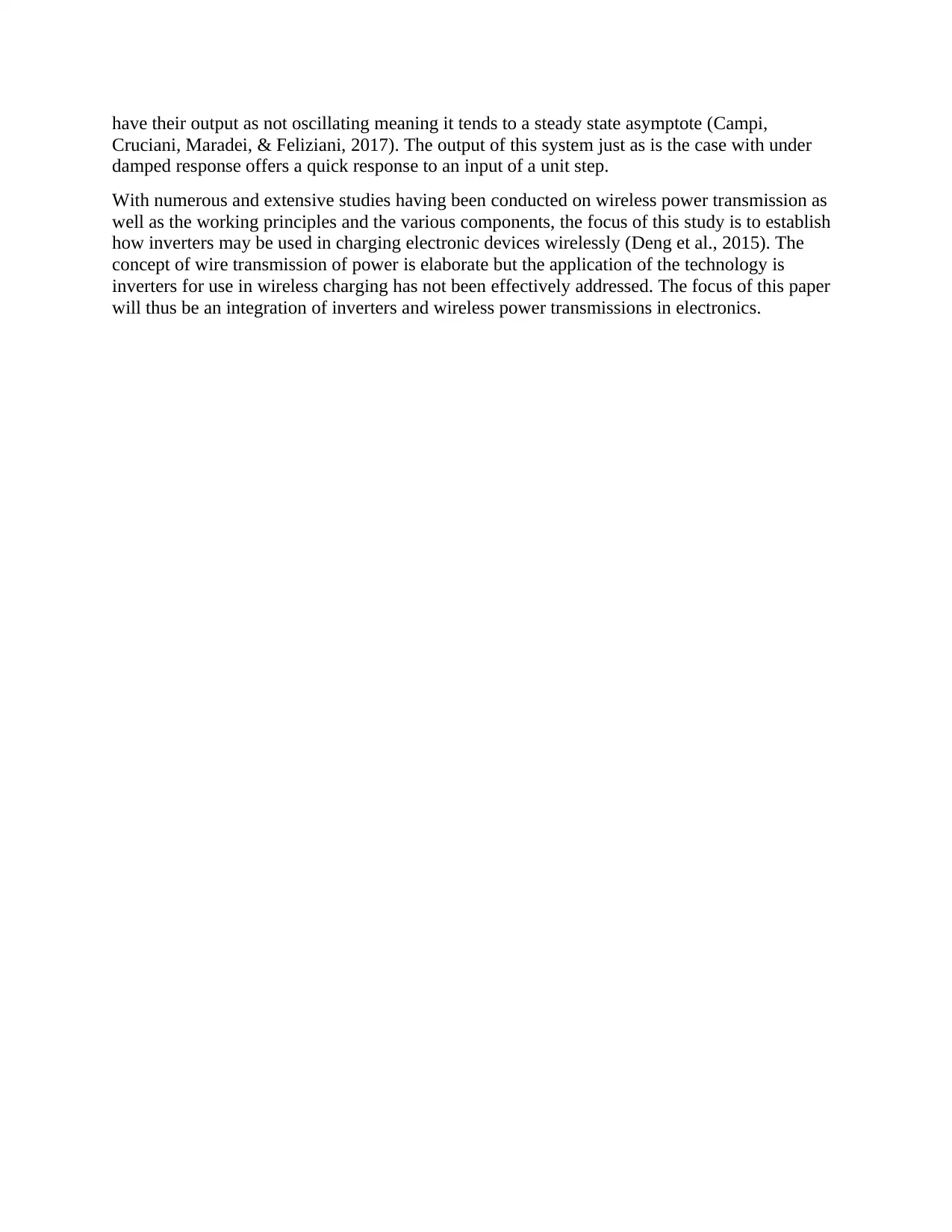
have their output as not oscillating meaning it tends to a steady state asymptote (Campi,
Cruciani, Maradei, & Feliziani, 2017). The output of this system just as is the case with under
damped response offers a quick response to an input of a unit step.
With numerous and extensive studies having been conducted on wireless power transmission as
well as the working principles and the various components, the focus of this study is to establish
how inverters may be used in charging electronic devices wirelessly (Deng et al., 2015). The
concept of wire transmission of power is elaborate but the application of the technology is
inverters for use in wireless charging has not been effectively addressed. The focus of this paper
will thus be an integration of inverters and wireless power transmissions in electronics.
Cruciani, Maradei, & Feliziani, 2017). The output of this system just as is the case with under
damped response offers a quick response to an input of a unit step.
With numerous and extensive studies having been conducted on wireless power transmission as
well as the working principles and the various components, the focus of this study is to establish
how inverters may be used in charging electronic devices wirelessly (Deng et al., 2015). The
concept of wire transmission of power is elaborate but the application of the technology is
inverters for use in wireless charging has not been effectively addressed. The focus of this paper
will thus be an integration of inverters and wireless power transmissions in electronics.
Secure Best Marks with AI Grader
Need help grading? Try our AI Grader for instant feedback on your assignments.
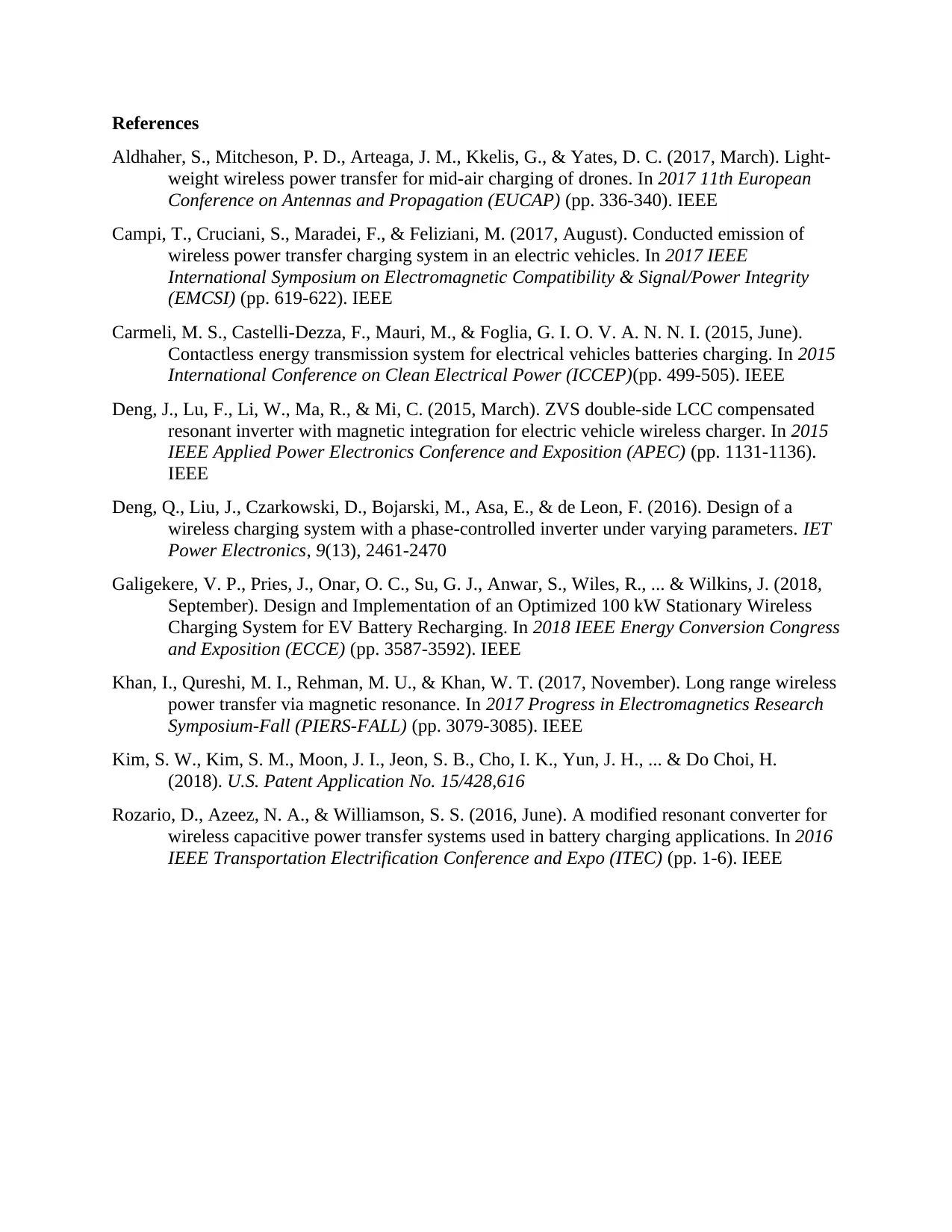
References
Aldhaher, S., Mitcheson, P. D., Arteaga, J. M., Kkelis, G., & Yates, D. C. (2017, March). Light-
weight wireless power transfer for mid-air charging of drones. In 2017 11th European
Conference on Antennas and Propagation (EUCAP) (pp. 336-340). IEEE
Campi, T., Cruciani, S., Maradei, F., & Feliziani, M. (2017, August). Conducted emission of
wireless power transfer charging system in an electric vehicles. In 2017 IEEE
International Symposium on Electromagnetic Compatibility & Signal/Power Integrity
(EMCSI) (pp. 619-622). IEEE
Carmeli, M. S., Castelli-Dezza, F., Mauri, M., & Foglia, G. I. O. V. A. N. N. I. (2015, June).
Contactless energy transmission system for electrical vehicles batteries charging. In 2015
International Conference on Clean Electrical Power (ICCEP)(pp. 499-505). IEEE
Deng, J., Lu, F., Li, W., Ma, R., & Mi, C. (2015, March). ZVS double-side LCC compensated
resonant inverter with magnetic integration for electric vehicle wireless charger. In 2015
IEEE Applied Power Electronics Conference and Exposition (APEC) (pp. 1131-1136).
IEEE
Deng, Q., Liu, J., Czarkowski, D., Bojarski, M., Asa, E., & de Leon, F. (2016). Design of a
wireless charging system with a phase-controlled inverter under varying parameters. IET
Power Electronics, 9(13), 2461-2470
Galigekere, V. P., Pries, J., Onar, O. C., Su, G. J., Anwar, S., Wiles, R., ... & Wilkins, J. (2018,
September). Design and Implementation of an Optimized 100 kW Stationary Wireless
Charging System for EV Battery Recharging. In 2018 IEEE Energy Conversion Congress
and Exposition (ECCE) (pp. 3587-3592). IEEE
Khan, I., Qureshi, M. I., Rehman, M. U., & Khan, W. T. (2017, November). Long range wireless
power transfer via magnetic resonance. In 2017 Progress in Electromagnetics Research
Symposium-Fall (PIERS-FALL) (pp. 3079-3085). IEEE
Kim, S. W., Kim, S. M., Moon, J. I., Jeon, S. B., Cho, I. K., Yun, J. H., ... & Do Choi, H.
(2018). U.S. Patent Application No. 15/428,616
Rozario, D., Azeez, N. A., & Williamson, S. S. (2016, June). A modified resonant converter for
wireless capacitive power transfer systems used in battery charging applications. In 2016
IEEE Transportation Electrification Conference and Expo (ITEC) (pp. 1-6). IEEE
Aldhaher, S., Mitcheson, P. D., Arteaga, J. M., Kkelis, G., & Yates, D. C. (2017, March). Light-
weight wireless power transfer for mid-air charging of drones. In 2017 11th European
Conference on Antennas and Propagation (EUCAP) (pp. 336-340). IEEE
Campi, T., Cruciani, S., Maradei, F., & Feliziani, M. (2017, August). Conducted emission of
wireless power transfer charging system in an electric vehicles. In 2017 IEEE
International Symposium on Electromagnetic Compatibility & Signal/Power Integrity
(EMCSI) (pp. 619-622). IEEE
Carmeli, M. S., Castelli-Dezza, F., Mauri, M., & Foglia, G. I. O. V. A. N. N. I. (2015, June).
Contactless energy transmission system for electrical vehicles batteries charging. In 2015
International Conference on Clean Electrical Power (ICCEP)(pp. 499-505). IEEE
Deng, J., Lu, F., Li, W., Ma, R., & Mi, C. (2015, March). ZVS double-side LCC compensated
resonant inverter with magnetic integration for electric vehicle wireless charger. In 2015
IEEE Applied Power Electronics Conference and Exposition (APEC) (pp. 1131-1136).
IEEE
Deng, Q., Liu, J., Czarkowski, D., Bojarski, M., Asa, E., & de Leon, F. (2016). Design of a
wireless charging system with a phase-controlled inverter under varying parameters. IET
Power Electronics, 9(13), 2461-2470
Galigekere, V. P., Pries, J., Onar, O. C., Su, G. J., Anwar, S., Wiles, R., ... & Wilkins, J. (2018,
September). Design and Implementation of an Optimized 100 kW Stationary Wireless
Charging System for EV Battery Recharging. In 2018 IEEE Energy Conversion Congress
and Exposition (ECCE) (pp. 3587-3592). IEEE
Khan, I., Qureshi, M. I., Rehman, M. U., & Khan, W. T. (2017, November). Long range wireless
power transfer via magnetic resonance. In 2017 Progress in Electromagnetics Research
Symposium-Fall (PIERS-FALL) (pp. 3079-3085). IEEE
Kim, S. W., Kim, S. M., Moon, J. I., Jeon, S. B., Cho, I. K., Yun, J. H., ... & Do Choi, H.
(2018). U.S. Patent Application No. 15/428,616
Rozario, D., Azeez, N. A., & Williamson, S. S. (2016, June). A modified resonant converter for
wireless capacitive power transfer systems used in battery charging applications. In 2016
IEEE Transportation Electrification Conference and Expo (ITEC) (pp. 1-6). IEEE
1 out of 5
Your All-in-One AI-Powered Toolkit for Academic Success.
+13062052269
info@desklib.com
Available 24*7 on WhatsApp / Email
![[object Object]](/_next/static/media/star-bottom.7253800d.svg)
Unlock your academic potential
© 2024 | Zucol Services PVT LTD | All rights reserved.
